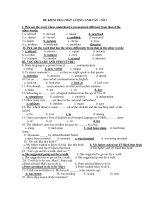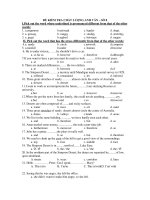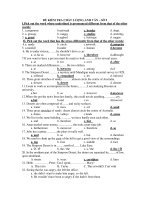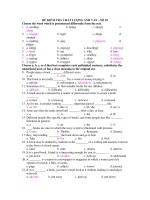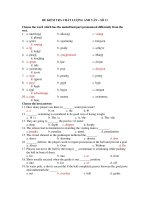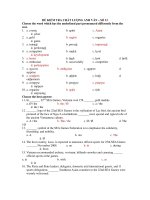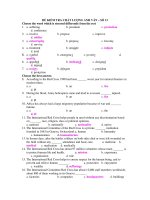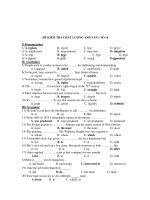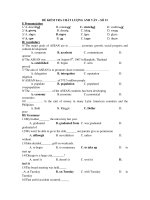ĐỀ KIỂM TRA TỔNG HỢP ANH VĂN - SỐ 4 potx
Bạn đang xem bản rút gọn của tài liệu. Xem và tải ngay bản đầy đủ của tài liệu tại đây (90.59 KB, 10 trang )
ĐỀ KIỂM TRA TỔNG HỢP ANH VĂN - SỐ 4
TEST 1
Read the passage and choose the best answer.
A family portrait is of great value - it is fun to look at now, it's great for relatives far way,
and it will bring back memories in the years to come. Families change quickly as children will
grow. So, plan to make this a regular event. Your family album isn't really complete without this
record of all of you together.
Getting the whole family together isn't always easy, so a careful plan must be made so
that everyone has time to pose. A relaxed, friendly feeling will make the good picture. People
can't be expected to relax when they are in a hurry to do something else. Make your plans when
you're all together then set a time convenient for everyone.
A family portrait will take some technical planning too. Make up your mind in advance
which room you will use. Choose your camera position and check the lighting. If you want to be
in the picture, make sure you, know exactly how the self-timer on your camera operates. With
most cameras you'll have from 8 to 12 seconds to get into the picture after you press the button.
1. Why is a family portrait valuable?
a. It's fun to look at.
b. It reminds people of the past.
c. It brings the family atmosphere to the faraway relatives.
d. All the above answers.
2. Taking the family portrait should be made a regular event because ……
a. children will go to the college when they grow up
b. there are constant changes in the family
c. the size of the family will increase d. the family will break up
3. What makes a good picture?
a. People's relaxed feeling. b. People's free time.
c. People's appearance. d. People's clothes.
4. What is the best time to make the plan?
a. When the time is convenient for everyone. b. When everyone is present. (xem lai)
c. When you're having meals. d. When you're not busy doing other things.
5. What technical planning should you do before taking a family portrait?
a. The camera and lighting.
b. The room and the camera's operation.
c. The place, the lighting, the camera position and the camera's operation
d. The camera position and its self-timer.
TEST 2
Choose the item (A, B, C or D) that best completes the unfinished statement.
University Entrance Examination is very important in Vietnamese students. High school
graduates have to take it and get high results to be admitted to universities. The pressure on the
candidates remains very high despite the measures that have been taken to reduce the heat
around these exams, since securing a place in a state university is considered a major step
towards a successful career for young people, especially those from rural areas or disadvantaged
families. In the year 2004, it was estimated that nearly 1 million Vietnamese students took the
University Entrance Examination, but on average only 1 out of 5 candidates succeeded.
Normally, candidates take 3 exam subjects, and each lasts; 180 minutes for the fixed group of
subjects they choose. There are 4 fixed groups of subjects: Group A: Mathematics, Physics, and
Chemistry; Group B: Mathematics, Biology, and Chemistry; Group C: Literature, History, and
Geography; Group D: Literature, Foreign Language, and Mathematics.
In addition to universities, there are community colleges, art and technology institutes;
professional secondary schools, and vocational schools which offer degrees or certificates from
a-few-month to 2-year courses.
According to Vietnam's Ministry of Education and Training, there are currently 23 non-
public universities, accounting for 11% of the total number of universities. These non-public
universities are currently training 119,464 students, or 11.7% of the total number of students.
The government is planning to increase the number of non-public universities to 30% by 2007.
1. University Entrance Examination in Vietnamese is very _______.
A. interesting B. stressful C. free D. easy
2. The word those refers to _______.
A. exam subjects B. young people C. universities D. examinations
3. In 2004, the proportion of the students who got success in University Entrance Examination
was about _______ percent.
A. 5 B. 10 C. 20 D. 50
4. Which sentence refers to the University Entrance Examination in Vietnam?
A. Students find it easy to get success in the University Entrance Examination.
B. Math is compulsory in the University Entrance Examination.
C. Students are not allowed to choose their exam subjects.
D. There are four fixed groups of exam subjects for students to choose.
5. According to the passage, _______.
A. the Vietnamese government will close all non-public universities by next year.
B. the Vietnamese government does not appreciate non-public universities
C. the Vietnamese government encourages the establishing of non-public universities.
D. Vietnamese students have no alternative to continue their higher study besides universities.
TEST 3
Read the passage below and choose the best answer
Many people now think that teachers give pupils too much homework. They say that it is
unnecessary for children to work at home in their free tine. Moreover, they argue that most
teachers do not properly plan the homework tasks they give to pupils. The result is that pupils
have to repeat tasks which they have already done at school, Recently in Greece many parents
said that most of the homework was a waste of time, and they wanted to stop it. Spain and
Turkey are two countries which stopped homework recently. In Denmark, Germany and several
countries in Europe, teachers cannot set homework at weekends. In Holland. teachers allow
pupils to slay o school to do their homework. The children are free to help one another. Similar
arrangements also exist in some British schools.
1. What is the writer’s main aim in the passage?
A. to complain about the difficult homework
B. to explain why the homework is difficult
C. to suggest that homework should be stopped
D. to avoid the problems of homework
2. By ‘most teachers do not properly plan the homework tasks they give to pupil the writer
means that _______
A. most teachers do not prepare very well and carefully the homework tasks
B. most teachers do not give the homework tasks to individual pupils
C. most teachers do not choose the suitable time to give the homework tasks
D. most teachers do not give the proper plan to pupils at home
3. Which of the following statements is TRUE according to the passage?
A. In some countries, children are free to choose proper homework at weekends.
B. Homework may be done at school.
C. parents are free to help their children to do their homework at school.
D. Homework was a waste of time to parents, not to children.
4. Which of the following statements is NOT true according to the passage?
A. Homework is still necessary if the teachers properly plan its tasks. B. Pupils can help
their friends to do homework.
C. Homework should not be done at weekends.
D. Homework helps pupils to improve their memory
5. 45. The best title for the passage is …
A. Homework, a Waste of Time
B. Homework, an Unnecessary Task
C. Different Solutions to Homework
D. Different Measurements to Plan Homework Tasks
TEST4
Read the passage carefully and choose the correct answer.
Species that belong to an area are said to be native species. Typically, they have been part of
a given biological landscape for a long period, and they are well adapted to the local
environment and to the presence of other native species in the same general habitat. Exotic
species are interlopers, foreign elements introduced intentionally or accidentally into new
settings through human activities. In one context an introduced species may cause no obvious
problems and may, over time, be regarded as being just as "natural" as any native species in the
same habitat. In another context, exotics may seriously disrupt delicate ecological balances and
create a cascade of unintended consequences. The worst of these unintended consequences arise
when introduced species put native species in destruction by preying on them, altering their
habitats, or out-competing them in the struggle for food resources. Although biological
introductions have affected environments the world over, the most destructive, effects have
occurred on islands, where introduced insects, cats, pigs, rats, mongooses, and other nonnative
species have caused the grave endangerment or outright extinction of literally hundreds of
species during the past 500 years.
One of other reason to cause species extinction is overexploitation. This word refers to the
utilization of a species at a rate that is likely to cause its extreme endangerment or outright
extinction. Among many examples of severe overexploitation, the case of the great whales stands
out in special relief. By the middle of the 20th century, unrestricted whaling had brought many
species of whales to incredibly low population sizes. In response to public pressure, in 1982 a
number of nations, including the USA, agreed to an international moratorium on whaling. As a
direct result, some whale species which are thought to have been on extinction's doorstep 25
years ago have made amazing comebacks, such as grey whales in the western Pacific. Others
remain at great risk. Many other species, however, continue to suffer high rates of exploitation
because of the trade in animal parts. Currently, the demand for animal parts is centered in several
parts of Asia where there. is a strong market for traditional medicines made from items like tiger
bone and rhino horn.
1. Native species _______.
a. are not used to the local environment b. never get along well with other native species in
the same environment
c. tend to do harm to exotic species d. have been part of a given biological landscape
for a long period
2. Exotic species _______.
a. do no harm to native species and the local environment
b. may kill native species for food
c. always share the environment peacefully with native species
d. help to make the local environment more ideal to survive
3. According to the first paragraph, _______.
a. non-native species have caused badly damage to native ones
b. introducing new exotic species to local environments is necessary
c. exotic species have never been introduced on islands
d. very few native species have been damaged by exotic species
4. According to the second paragraph, by the middle of the 20 century ___.
a. whale population was the most crowded in marine life b. whale hunting was
illegal
c. whale population increased dramatically d. whaling was not
restricted
5. Tiger bone and rhino horn _______.
a. are not popular in Asian markets b. are never in the trade of
animal parts
c. are used for making traditional medicines d. cannot be found in Asian
markets
TEST 5
Read the passage carefully and choose the correct answer.
Reading, as you know, is a continuous and never ending process. If you do very little
reading, or if you read only material that offers no challenge to your comprehension, your
reading will be of very little use. Once we reach a certain age, or once our formal schooling is
completed, many of us become so restricted in our choice of .reading that we rarely read any new
type of reading experience. We tend to read only books in our professional or business field, or
only inspirational books, or only our favorite newspapers every morning, or only one magazine
for which we have developed a preference. And the trouble starts here. You should neither read
only for entertainment nor only for information but you should also read for intellectual growth,
for mental stimulation, for enriching your background of knowledge, for wisdom, and for
broader outlook and mature understanding. What kind of books should you read to continue your
intellectual growth, to gain a background for opinion and for judgment? The answer is simple
one: Read books in fields you have little or no acquaintance with, books that will open for you
new horizons of learning, books that will help you explore new areas of knowledge and
experience, books that will make the world and people more understandable to you. Sadly, more
and more people today are giving up the printed word in favor of being entertained and informed
by watching TV, a popular entertainment ,device present at almost homes. More and more
children are being subjected to TV programming, perhaps as a babysitter. More than two hours
of TV time per day are now a part of children development, generating physiological and mental
problems that are of growing concern among experts.
1. Reading ________.
a. completely stops when we finish our schooling c. is of little use
b. is an endless process d. should be done a little
2. According to the text, ________.
a. new type of reading experience often interests most of us . b. we should only read for
entertainment
c. reading for intellectual growth is necessary d. we should not read for
mental stimulation
3. What kind of books is recommended?
a. Books in fields you have little or no acquaintance with
b. Books that will help you explore new areas of knowledge and experience
c. Books that will open for you new horizons of learning
d. All are correct
4. We can learn from the text that today ________.
a. people spend more time watching TV than reading books
b. more and more people enjoy reading
c. most babysitters prefer watching TV
d. most children spend less than 2 hours a day watching TV
5. The writer ________.
a. does not approve of reading process c. prefers watching TV to reading
b. advises us to read as little as possible d. appreciates reading
TEST 6
Read the passage carefully and choose the correct answer.
Today, more and more women are actively participating in social activities both in urban
and rural areas. Specifically, they have shined brightly in even many fields commonly regarded
as the man's areas such as business, scientific research and social management. In some areas,
women even show more overwhelming power than men. The image of contemporary
Vietnamese women with creativeness, dynamism, success has become popular in Vietnam's
society. The fact reveals that the gender gap has been remarkably narrowed and women enjoy
many more opportunities to pursue their social careers and obtain success, contributing to
national socio-economic development. According to Ms, Le Thi Quy, Director of the Gender/and
Development Research Centre under the University of Social Sciences and Humanities, Hanoi
National University, gender equity in Vietnam has reached a high level over the past decade. The
rate of Vietnamese women becoming National Assembly members from the 9th term to the 11th
term increased 8.7%, bringing the proportion of Vietnamese women in authority to 27.3%, the
highest rate in Southeast Asia. There is no big gap in the level of literacy and schooling between
men and women. Women account for about 37% of university and college graduates, 19.9% of
doctoral degree holders and 6.7% of professors and associate professors.
The legitimate rights of women and children are ensured more than ever before with more
complete legal documents including laws, conventions and national action plans, among which
the laws on "gender equity" mark a turning-point in the empowerment of women.
Mass media also highlights the continued success of women in every field and honors their
great importance in modern society, helping to do away with outdated perceptions about
traditional women's duties. Many projects on reproductive health care, children protection, and
family income improvement jointly conducted by various mass organizations, state agencies and
non-governmental organizations have created favorable conditions for women to become
involved.
1. The text is about ________.
a. the changes in the status of Vietnamese women
b. the Vietnamese women's liberation
c. the Vietnamese sex discrimination
d. the discrimination that Vietnamese women have to face
2. Which adjective is not used to describe Vietnamese women?
a. successful b. creative c. narrow d. dynamic
3. According to the data in the text, ________.
a. Vietnamese women do not take part in authority
b. the level of literacy and schooling between men and women in Vietnam is the same
c. there are more women in authority in Vietnam than those in any other countries in
Southeast Asia .
d. there are no female professors in Vietnam
4. Vietnamese women ________.
a. have few opportunities to develop their intellectual ability
b. have only shined brightly in doing housework
c. cannot do any scientific research
d. are ensured their rights with laws, conventions and national action plans
5. Which is not mentioned in the text as a project to create condition for Vietnamese women?
a. Traditional women's duties b. Reproductive health care
c. Children protection d. Family income improvement
TEST 7
Read the passage carefully and choose the correct answer.
On 8 August 1967, five leaders - the Foreign Ministers of Indonesia, Malaysia, the
Philippines, Singapore and Thailand- sat down together in the main hall of the Department of
Foreign Affairs building in Bangkok, Thailand and signed a document. By virtue of that
document, the Association of Southeast Asian Nations (ASEAN) was born. The five Foreign
Ministers who signed it have been considered as the founders of probably the most successful
intergovernmental organization in the developing world today. The document that they signed
would be known as the ASEAN Declaration.
It is a short, simply-worded document containing just five articles. It declares the
establishment of an Association for Regional Cooperation among the Countries of Southeast
Asia to be known as the Association of Southeast Asian Nations (ASEAN) and spells out the
aims and purposes of that Association. These aims and purposes are about the cooperation in
economy, society, culture, techniques, education and other fields, and in the promotion of
regional peace and stability through abiding respect for justice and the principles of the United
Nations Charter. It stipulates that the Association will be open for participation by all States in
the Southeast Asian region subscribing to its aims, principles and purposes. It proclaims ASEAN
as representing the collective will of the nations of Southeast Asia to bind themselves together in
friendship and cooperation and, through joint efforts and sacrifices, secure for their peoples and
for posterity the blessings of peace, freedom and prosperity. The goal of ASEAN, then, is to
create, not to destroy.
The original ASEAN logo presented five brown sheaves of rice stalks, one for each
founding member. Beneath the sheaves is the legend "ASEAN" in blue. These are set on a field
of yellow encircled by a blue border. Brown stands for strength and stability, yellow for
prosperity and blue for the spirit of cordiality in which ASEAN affairs are conducted. When
ASEAN celebrated its 30
th
Anniversary in 1997, the sheaves on the logo had increased to ten -
representing all ten countries of Southeast Asia and reflecting the colors of the flags of all of
them. In a very real sense, ASEAN and Southeast Asia will be one and the same, just as the
founders had envisioned.
1. The Association of Southeast Asian Nations ________.
a. consists of some Western nations
b. was established by the Philippines
c. was founded on 8 August 1967
d. was established by the Minister of the Department of Foreign Affairs of Thailand
2. The pronoun it in the first paragraph refers to ________.
a. the Association of Southeast Asian Nations
b. the most successful inter-governmental organization
c. Bangkok
d. the ASEAN Declaration
3. Which adjective can be used to describe the Association of Southeast Asian Nations?
a. successful b. illegal c. nongovernmental d. developing
4. Which does not belong to the purpose and aim of the Association of Southeast Asian
Nations?
a. friendship b. destruction c. creation d. cooperation
5. Up to 1997 how many countries there have been in ASEAN?
a. 5 b. 6 c. 8 d. 10
TEST 8
Choose the item (A, B, C or D) that best completes the unfinished statement.
In 1988, for the first time in British history, a National Curriculum was introduced.
The National Curriculum tells pupils which subjects they have to study, what they must
learn and when they have to take assessment tests.
Between the ages of 14 and 16, pupils study for their GCSE (General Certificate of
Secondary Education) exams. Pupils must take English Language, Maths and Science for
GCSE, as well as a half GCSE in a foreign language and Technology. In addition, they
must also be taught Physical Education, Religious Education and Sex Education, although
they do not take exams in these subjects.
At the age of 16, pupils can leave school. If pupils stay on, they usually take A
(Advanced) levels, AS (Advanced Supplementary) level or GNVQs (Greater National
Vocational Qualifications). It is quite common to combine, for example, two A levels
with one AS level, or one A level with one GNVQ.
Pupils taking A levels study traditional subjects, such as French, Physics or History.
To go to university, pupils usually need two or three A levels.
AS levels are the same standard as A levels, but only half of the content: AS level
German pupils take the A-level German language exam, but do not take the A-level
German Literature exam.
GNVQs are vocational qualifications. Pupils usually take on GNVQ in subjects such
as Business, Leisure and Tourism, Manufacturing, and Art and Design. One GVNQ (at
advanced level) is equal to two A levels.
1. Britain began to have a National Curriculum .
A. one hundred years ago B. in the nineteenth century
C. in 1898
D. in 1988
2. Which of the following subjects do British students NOT take exams in?
A. Science
B. Physical Education
C. Maths D. English Language
3. Pupils need………….A levels to continue to study at university.
A. one or two
B. two or three
C. four or five D. five or six
4. Which of the following subjects do pupils NOT take on GNVQ in?
A. German Literature
B. Business
C. Art and Design D. Manufacturing
5. Pupils normally study for their GCSE between the ages of…………
A. 12 and 14 B. 14 and 16 C. 15 and 17
D. 16 and 18
TEST 9
Choose the item (A, B, C or D) that best completes the unfinished statement
The planet Earth is 4, 600 million years old. It is difficult for us to think about such an
enormous length of time because it has little meaning for us. We can, however, simplify the idea
to make it more understandable. We can compare the planet Earth to a person of forty-six years
of age.
Nothing is known about the first seven years of this persons life. Very little information exists
about the middle period either. It was only at the age of forty-two that the Earth began to flower.
Dinosaurs and great reptiles did not appear until one year ago, when the planet was forty-five.
Mammals only arrived eight months ago. In the middle of last week, man-like apes became ape-
like men and began to communicate with each other. Last weekend, the Ice Age covered the
Earth.
Modem man has only been around for four hours. During the last hour man discovered
agriculture. The Industrial Revolution and the rise of large cities began just sixty seconds ago.
During that short time, modern man has made a rubbish tip of the Earth. In one minute, he
has increased his numbers to terrible proportions and has caused the death of hundreds of species
of animals. He has robbed and destroyed the planet in his search for fuels. Now he stands, like a
violent, spoiled child, delighted at the speed of his rise to power, on the edge of the final mass
destruction and of killing all the life which exists in the solar system.
1. The passage tells us that
A. a great deal is known about how the Earth was created.
B. life on Earth began relatively recently.
C. more is known about the first part of the Earths life than the middle part.
D. scientists are well - informed about the middle part of the Earth’s life.
2. We are informed by the author that
A. the dinosaurs appeared during the middle period.
B. mammals and great reptiles both appeared at the same time.
C. there were more than forty—five kinds of great reptiles.
D. ape - like men appeared before the last Ice Age.
3. The author is mainly interested in
A. the time when man first evolved from apes.
B. what has happened since the Industrial Revolution.
C. the effects of farming.
D. the period before the last Ice Age.
4. It would appear that the main danger ahead is that
A. man will destroy everything on Earth.
B. man will use up all the fuels.
C. there will be a population explosion.
D. more species of animals may die out.
5. The author’s general view of man seems to be that
A. he has no right to be so destructive.
B. he has been the most successful animal.
C. he will be able to control the environment.
D. he has learned a lot from past mistakes.
TEST 10
Read the passage below and choose the best answer for each question
Ever since humans have inhabited the earth, they have made use of various forms of
communication. Generally, this expression of thoughts and feelings has been in the form of oral
speech. When there is a language barrier, communication is accomplished through sign language
in which motions stand for letters, words, and ideas. Tourists, the deaf, and the mute have had to
resort to this form of expression. Many of these symbols of whole words are very picturesque
and exact and can be used internationally; spelling, however, cannot.
Body language transmits ideas or thoughts by certain actions, either intentionally or
unintentionally. A wink can be a way of flirting or indicating that the party is only joking. A nod
signifies approval, while shaking the head indicates a negative reaction.
Other forms of nonlinguistic language can be found in Braille (a system of raised dots
read with the fingertips), signal flags. Morse code, and smoke signals. Road maps and picture
signs also guide, warn, and instruct people.
While verbalization is the most common form of language, other systems and techniques
also express human thoughts and feelings.
1. Which form other than oral speech would be most commonly used among blind people?
A. picture signs B. Braille C. body language D. signal flags
2. How many different forms of communication are mentioned here?
A. 5 B.7 C.9 D. 11
3. Sign language is said to be very picturesque and exact and can be, used
internationally EXCEPT for ______.
A. spelling B. ideas C. whole words D. expressions
4. Which of the following best summarizes this passage?
A. When language is a barrier, people will find other forms of communication.
B. Everybody uses only one form of communication.
C. Nonlinguistic language is invaluable to foreigners.
D. Although other forms of communication exist, verbalization is the fastest
5. Which of the following statements is NOT true?
A. There are many forms of communication in existence today.
B. Verbalization is the most common form of communication.
C. The deaf and mute use an oral form of communication.
D. Ideas and thoughts can be transmitted by body language.

